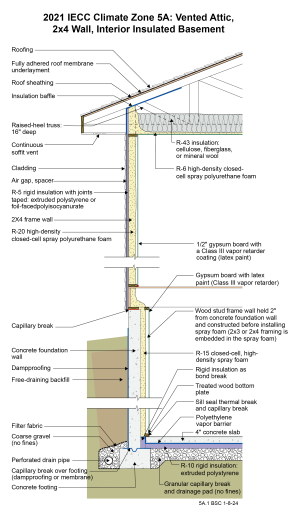
2021 IECC Climate Zone 5A Building Assembly: Vented Attic, 2x4 Wall, Interior Insulated Basement
2021 IECC Climate Zone 5A: Vented Attic, 2x4 Wall, Interior Insulated Basement
Notes
Drawing 5A.1: IECC CZ 5: Vented Attic, 2x4 Wall, Interior Insulated Basement
- The closed-cell high-density spray foam provides the air control layer (air barrier) and the vapor control layer in both the ceiling and the wall. It also provides shear strength (“racking resistance”) in the wall.
- The function of the raised-heel roof truss is to control the temperature of the interior corner where the exterior wall meets the ceiling to control dust marking and mold. The minimum thermal resistance over the top of the wall assembly should match or exceed the thermal resistance of the wall assembly. Increasing the height of the raised heel can allow lower attic insulation levels by code. Per IECC 2021 Section R402.2.1, Ceilings with Attics, the ceiling insulation of this assembly can be R-49 rather than R-60 due to the full-height raised-heel roof truss.
- A low-permeance roofing underlayment (less than 1 perm) is recommended for this roof type in this climate to reduce water diffusion through the underlayment to the sheathing.
- The rigid foam on the exterior of the wall allows construction without using structural sheathing: alternative methods of wall bracing are used instead, and the rigid foam provides a backstop for the cavity insulation as well as some structural support to the siding. Many contractors have found this to be a more economical approach.
- The spray foam in the rim joist cavity may need fire protection such as gypsum board or intumescent paint. Wood fire blocking may be required at the top of the basement wall, depending on the jurisdiction.
- The vertical “short” strip of rigid insulation where the basement concrete slab intersects the exterior concrete basement wall has the under-slab polyethylene vapor barrier extending over the top of it. This polyethylene is sealed with the spray foam to the concrete foundation wall. This provides air control layer continuity between the concrete slab/polyethylene assembly and the concrete wall to control radon and other soil gases.
- Horizontal insulation on the underside of the concrete floor slab is provided for comfort reasons and to control dust mites in carpets by reducing the relative humidity within the carpets.
2021 IECC Window Detail: Framed Wall with Rigid Insulation and Siding (Wood, Fiber Cement, Aluminum or Vinyl)
Notes
Window Detail 6 - Framed Wall with Rigid Insulation and Siding (Wood, Fiber Cement, Aluminum or Vinyl)
- Note: Always follow the window manufacturer’s installation guidance. Not following manufacturer guidance may void the warranty.
- This is a “drained wall”. The exterior face of the rigid insulation is carefully taped at all seams, allowing it to act as the water control layer. Drainage occurs between the siding and the exterior face of the rigid insulation. A drainage gap is provided by furring installed vertically over the exterior face of the rigid insulation at stud locations.
- The window openings are drained to the exterior face of the rigid foam since it is acting as the water control layer.
- The rough opening at the windowsill is sloped and flashed to the rigid foam with a formable flashing.
- The upper portion of the head trim flashing goes under the furring and is taped directly to the rigid foam with flashing tape. The furring is “cut through” by the head trim flashing, so that the furring below the flashing (behind the head trim) is separate from the furring above the flashing (behind the siding). During construction, the head trim is installed first on short pieces of furring. It is flashed directly to the rigid foam as described above. The rest of the furring is installed with the siding.
- A formable flashing membrane connects the rigid foam to the wood frame. It should extend inwards at least past the point where the interior air seal is located around all sides of the window frame. This creates water-resistant surfaces inside the cavity between the window flanges and the interior air seal, in case any water gets behind the flanges. The head and jamb window flanges are flashed to the rigid foam using a self-adhered flashing membrane. The sill window flange is not flashed, to allow any water that may get behind the flanges to escape.
- This assembly relies heavily on the use of proper tapes, flashings, and membranes that will adhere securely and durably to the rigid foam. Products should only be used if they have been well-established to be appropriate for this application.
- Note the gap between the head trim and the top of the window assembly frame. This gap allows water to drain and allows the bottom of the trim to dry out more easily. If installed without this gap, capillary action can draw water into the tight space between the head trim and the window assembly frame. Note also the gap between the siding and the head trim flashing, which serves the same purposes.
- Consider installing rigid head flashing (rigid head flashing is not shown in the schematic). Rigid head flashing is similar to the head trim flashing shown in the schematic, but it goes over the top of the window frame instead of over the head trim. This is required by some manufacturers. It should be installed against the head nailing flange and over the top of the window frame. The vertical and horizontal portion of the flashing should be sealed directly to the window frame and flange with sealant. The red flashing membrane strip shown overlapping the head nailing flange in the schematic would now overlap the rigid head flashing. Use rigid head flashing with a drip edge to guide water away from the window assembly.
- Backer rod for the interior air sealant should be installed after the window is installed, leveled, and shimmed. Use the correct size backer rod.

